Impact of Unprofessional Conduct on Healthcare Documentation Practices
VerifiedAdded on 2022/09/28
|6
|1314
|18
Essay
AI Summary
This essay analyzes unprofessional conduct in healthcare, particularly concerning documentation practices. It identifies five examples of unprofessional conduct, including failure to document assessment findings, improper medication documentation, and errors in procedures and patient information. The essay then explores the impact of these practices on various departments, including nursing, physicians, nutrition, the laboratory, and pharmacy, highlighting how documentation errors can lead to adverse patient outcomes, medical errors, and increased costs. The conclusion emphasizes the importance of professional practice and thorough documentation to ensure patient safety and effective communication across all departments involved in patient care. The essay uses references to support its claims and provides a comprehensive overview of the topic.
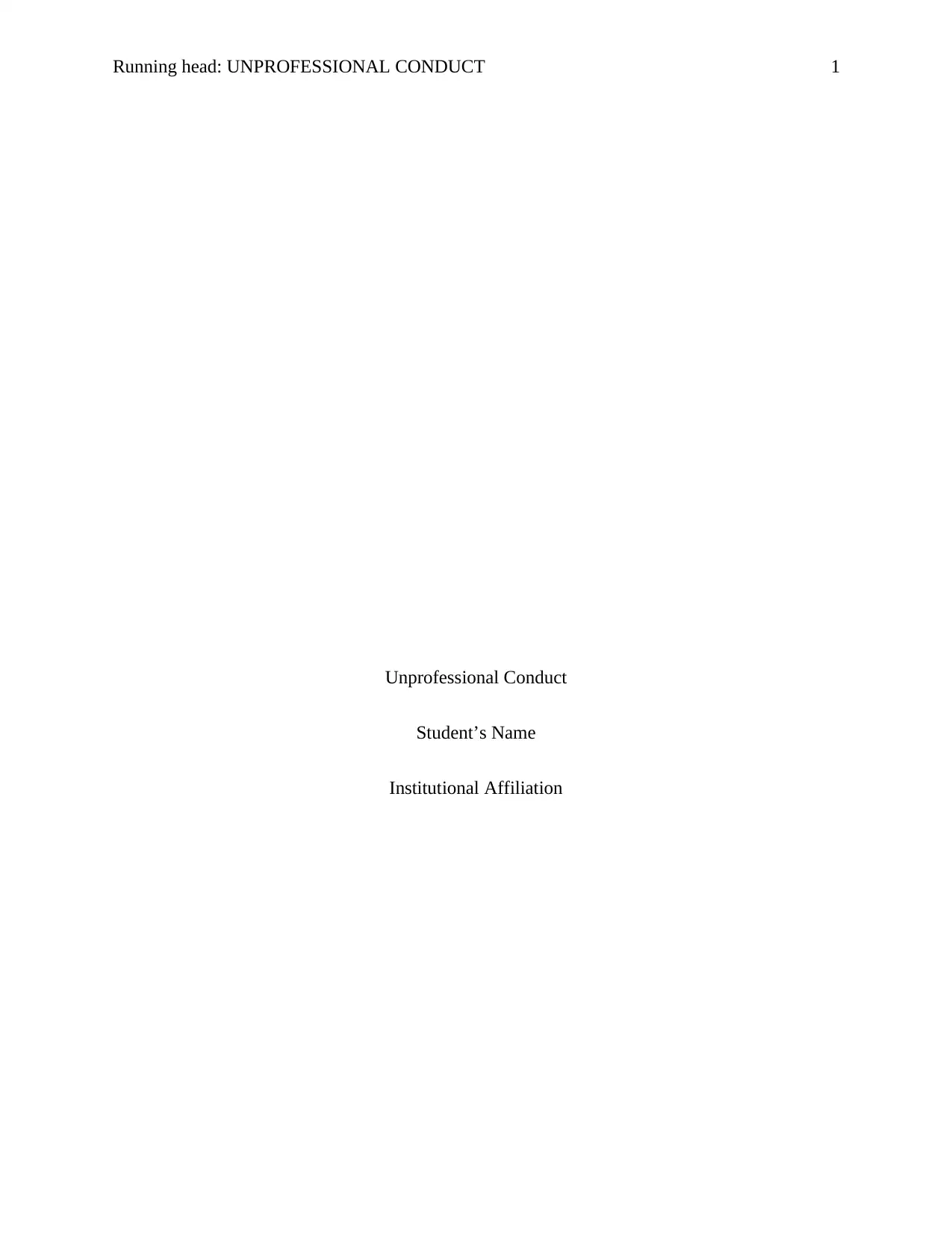
Running head: UNPROFESSIONAL CONDUCT 1
Unprofessional Conduct
Student’s Name
Institutional Affiliation
Unprofessional Conduct
Student’s Name
Institutional Affiliation
Paraphrase This Document
Need a fresh take? Get an instant paraphrase of this document with our AI Paraphraser
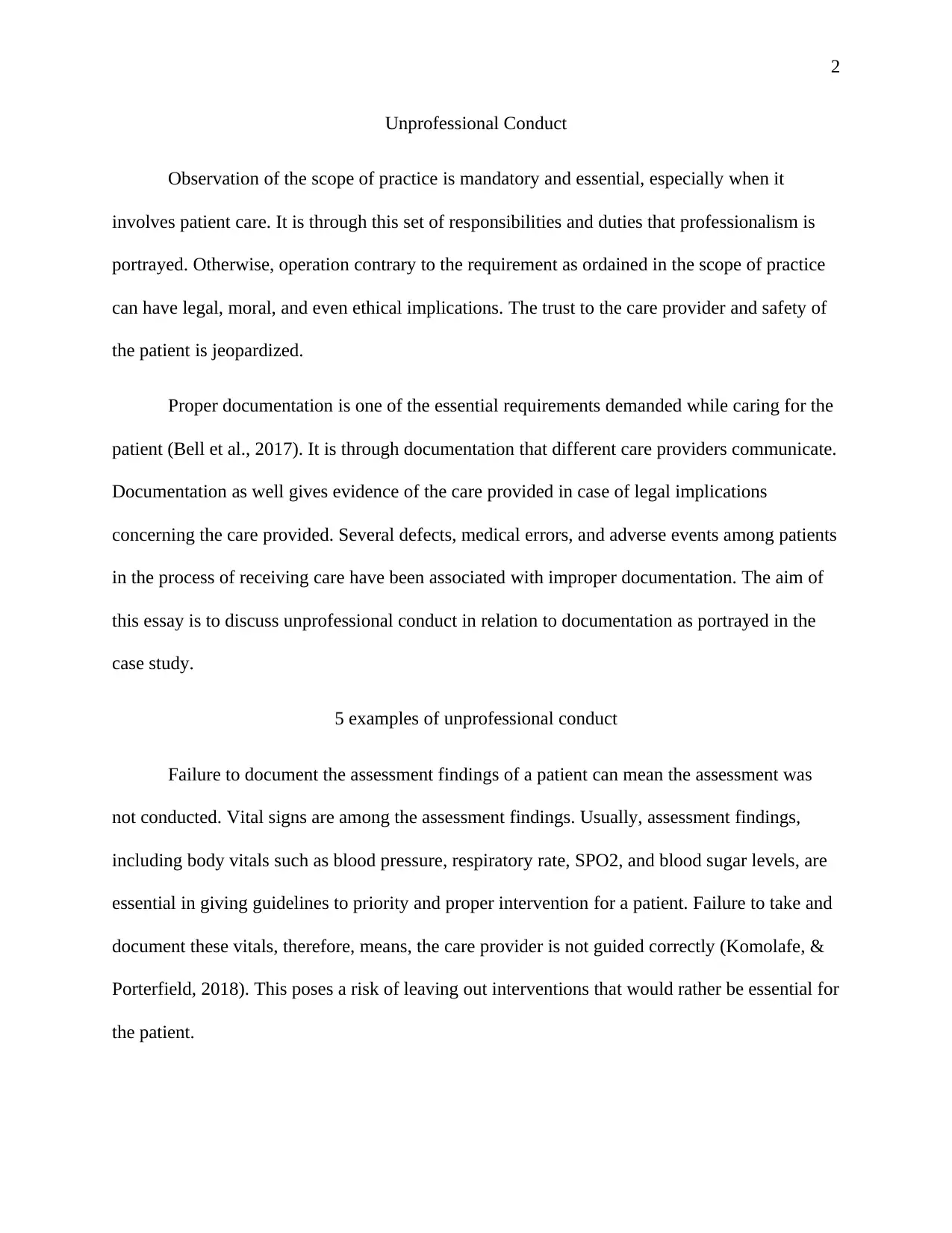
2
Unprofessional Conduct
Observation of the scope of practice is mandatory and essential, especially when it
involves patient care. It is through this set of responsibilities and duties that professionalism is
portrayed. Otherwise, operation contrary to the requirement as ordained in the scope of practice
can have legal, moral, and even ethical implications. The trust to the care provider and safety of
the patient is jeopardized.
Proper documentation is one of the essential requirements demanded while caring for the
patient (Bell et al., 2017). It is through documentation that different care providers communicate.
Documentation as well gives evidence of the care provided in case of legal implications
concerning the care provided. Several defects, medical errors, and adverse events among patients
in the process of receiving care have been associated with improper documentation. The aim of
this essay is to discuss unprofessional conduct in relation to documentation as portrayed in the
case study.
5 examples of unprofessional conduct
Failure to document the assessment findings of a patient can mean the assessment was
not conducted. Vital signs are among the assessment findings. Usually, assessment findings,
including body vitals such as blood pressure, respiratory rate, SPO2, and blood sugar levels, are
essential in giving guidelines to priority and proper intervention for a patient. Failure to take and
document these vitals, therefore, means, the care provider is not guided correctly (Komolafe, &
Porterfield, 2018). This poses a risk of leaving out interventions that would rather be essential for
the patient.
Unprofessional Conduct
Observation of the scope of practice is mandatory and essential, especially when it
involves patient care. It is through this set of responsibilities and duties that professionalism is
portrayed. Otherwise, operation contrary to the requirement as ordained in the scope of practice
can have legal, moral, and even ethical implications. The trust to the care provider and safety of
the patient is jeopardized.
Proper documentation is one of the essential requirements demanded while caring for the
patient (Bell et al., 2017). It is through documentation that different care providers communicate.
Documentation as well gives evidence of the care provided in case of legal implications
concerning the care provided. Several defects, medical errors, and adverse events among patients
in the process of receiving care have been associated with improper documentation. The aim of
this essay is to discuss unprofessional conduct in relation to documentation as portrayed in the
case study.
5 examples of unprofessional conduct
Failure to document the assessment findings of a patient can mean the assessment was
not conducted. Vital signs are among the assessment findings. Usually, assessment findings,
including body vitals such as blood pressure, respiratory rate, SPO2, and blood sugar levels, are
essential in giving guidelines to priority and proper intervention for a patient. Failure to take and
document these vitals, therefore, means, the care provider is not guided correctly (Komolafe, &
Porterfield, 2018). This poses a risk of leaving out interventions that would rather be essential for
the patient.

3
Improper documentation of medication was another unprofessional conduct identified.
The care provider failed to indicate that Septra was not given hence making the patient miss out
his/her medication. Missing of medication implied the patient has a more extended hospital stay
than expected before recovering. Failure of compliance with dosage could also lead to drug
resistance and even reaction.
Failure to document the wrong procedure carried out to a patient at an inappropriate time
was another unprofessional conduct. Ideally, patients ought not to be fed 6 hours before
undergoing surgery. This is due to the risk of aspiration. The administration of anesthesia makes
the muscles relax. The presence of food not only stimulates the production of digestive juices but
also poses a risk inhalation of foreign particles into the respiratory system, which is life-
threatening.
Failure to document that the jugular CVC was removed as well as that the care provider
flashed the CVC line at an inappropriate time using the wrong solution was unprofessional.
Failure to document the removal of the jugular CVC line would have a devastating effect in case
the patient needed emergency care. It would have taken more time for the next care providers
attending the patient to locate a CVC line in case emergency care was required. This would mean
a delay in administering needed care, which can cost the life of the patient. The administration of
the wrong solution could cause an unexpected adverse reaction in the patient. Without
documentation, other care providers won't perceive this as a reaction to intervene correctly.
Failure to document correct patient information and history during admission was
unprofessional conduct. During admission, medical information, both present, and past are
essential as well as other information, including social and economic. Vital and assessment
information all combined give a basis for diagnosis, intervention, and even diagnostic tests
Improper documentation of medication was another unprofessional conduct identified.
The care provider failed to indicate that Septra was not given hence making the patient miss out
his/her medication. Missing of medication implied the patient has a more extended hospital stay
than expected before recovering. Failure of compliance with dosage could also lead to drug
resistance and even reaction.
Failure to document the wrong procedure carried out to a patient at an inappropriate time
was another unprofessional conduct. Ideally, patients ought not to be fed 6 hours before
undergoing surgery. This is due to the risk of aspiration. The administration of anesthesia makes
the muscles relax. The presence of food not only stimulates the production of digestive juices but
also poses a risk inhalation of foreign particles into the respiratory system, which is life-
threatening.
Failure to document that the jugular CVC was removed as well as that the care provider
flashed the CVC line at an inappropriate time using the wrong solution was unprofessional.
Failure to document the removal of the jugular CVC line would have a devastating effect in case
the patient needed emergency care. It would have taken more time for the next care providers
attending the patient to locate a CVC line in case emergency care was required. This would mean
a delay in administering needed care, which can cost the life of the patient. The administration of
the wrong solution could cause an unexpected adverse reaction in the patient. Without
documentation, other care providers won't perceive this as a reaction to intervene correctly.
Failure to document correct patient information and history during admission was
unprofessional conduct. During admission, medical information, both present, and past are
essential as well as other information, including social and economic. Vital and assessment
information all combined give a basis for diagnosis, intervention, and even diagnostic tests
⊘ This is a preview!⊘
Do you want full access?
Subscribe today to unlock all pages.

Trusted by 1+ million students worldwide
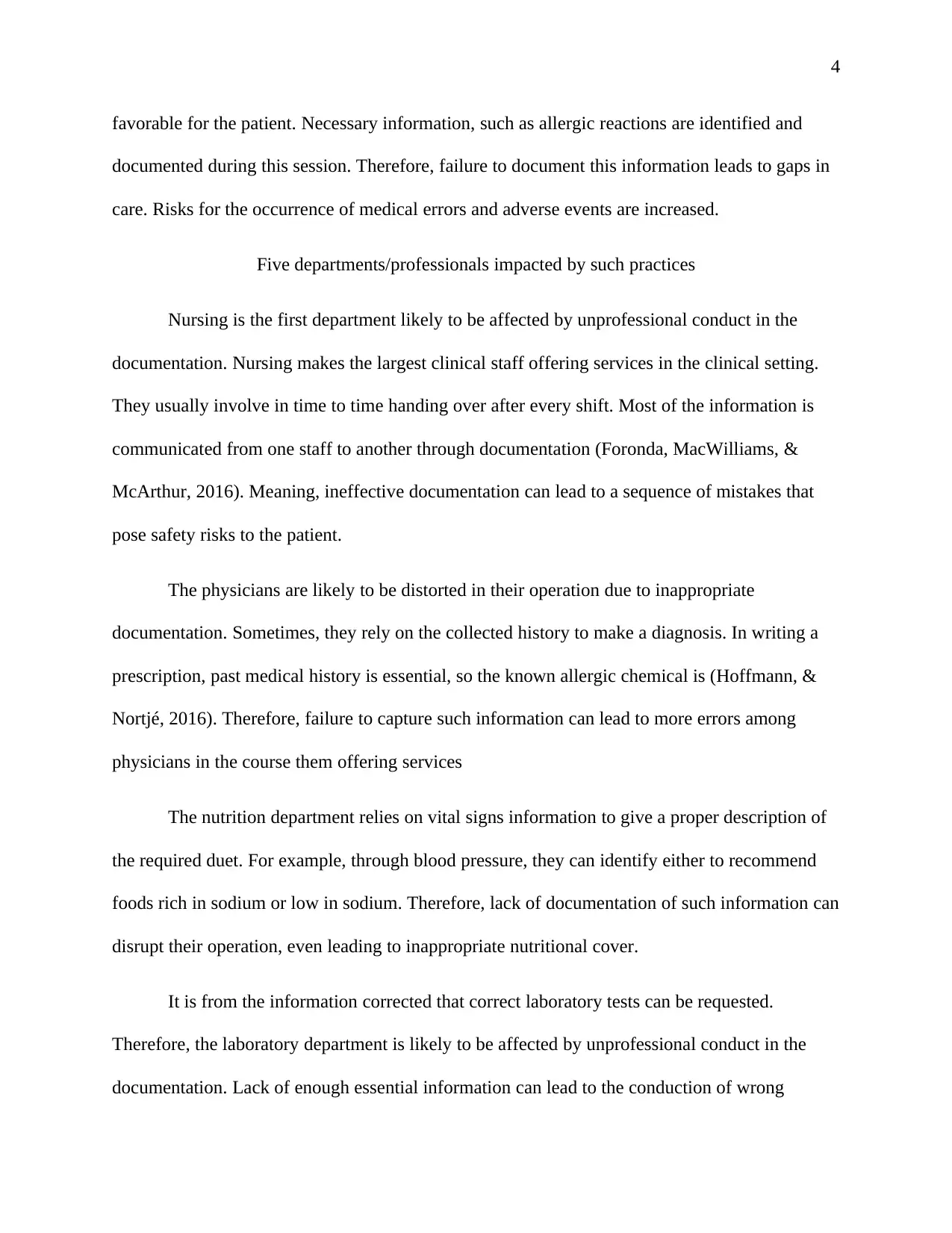
4
favorable for the patient. Necessary information, such as allergic reactions are identified and
documented during this session. Therefore, failure to document this information leads to gaps in
care. Risks for the occurrence of medical errors and adverse events are increased.
Five departments/professionals impacted by such practices
Nursing is the first department likely to be affected by unprofessional conduct in the
documentation. Nursing makes the largest clinical staff offering services in the clinical setting.
They usually involve in time to time handing over after every shift. Most of the information is
communicated from one staff to another through documentation (Foronda, MacWilliams, &
McArthur, 2016). Meaning, ineffective documentation can lead to a sequence of mistakes that
pose safety risks to the patient.
The physicians are likely to be distorted in their operation due to inappropriate
documentation. Sometimes, they rely on the collected history to make a diagnosis. In writing a
prescription, past medical history is essential, so the known allergic chemical is (Hoffmann, &
Nortjé, 2016). Therefore, failure to capture such information can lead to more errors among
physicians in the course them offering services
The nutrition department relies on vital signs information to give a proper description of
the required duet. For example, through blood pressure, they can identify either to recommend
foods rich in sodium or low in sodium. Therefore, lack of documentation of such information can
disrupt their operation, even leading to inappropriate nutritional cover.
It is from the information corrected that correct laboratory tests can be requested.
Therefore, the laboratory department is likely to be affected by unprofessional conduct in the
documentation. Lack of enough essential information can lead to the conduction of wrong
favorable for the patient. Necessary information, such as allergic reactions are identified and
documented during this session. Therefore, failure to document this information leads to gaps in
care. Risks for the occurrence of medical errors and adverse events are increased.
Five departments/professionals impacted by such practices
Nursing is the first department likely to be affected by unprofessional conduct in the
documentation. Nursing makes the largest clinical staff offering services in the clinical setting.
They usually involve in time to time handing over after every shift. Most of the information is
communicated from one staff to another through documentation (Foronda, MacWilliams, &
McArthur, 2016). Meaning, ineffective documentation can lead to a sequence of mistakes that
pose safety risks to the patient.
The physicians are likely to be distorted in their operation due to inappropriate
documentation. Sometimes, they rely on the collected history to make a diagnosis. In writing a
prescription, past medical history is essential, so the known allergic chemical is (Hoffmann, &
Nortjé, 2016). Therefore, failure to capture such information can lead to more errors among
physicians in the course them offering services
The nutrition department relies on vital signs information to give a proper description of
the required duet. For example, through blood pressure, they can identify either to recommend
foods rich in sodium or low in sodium. Therefore, lack of documentation of such information can
disrupt their operation, even leading to inappropriate nutritional cover.
It is from the information corrected that correct laboratory tests can be requested.
Therefore, the laboratory department is likely to be affected by unprofessional conduct in the
documentation. Lack of enough essential information can lead to the conduction of wrong
Paraphrase This Document
Need a fresh take? Get an instant paraphrase of this document with our AI Paraphraser
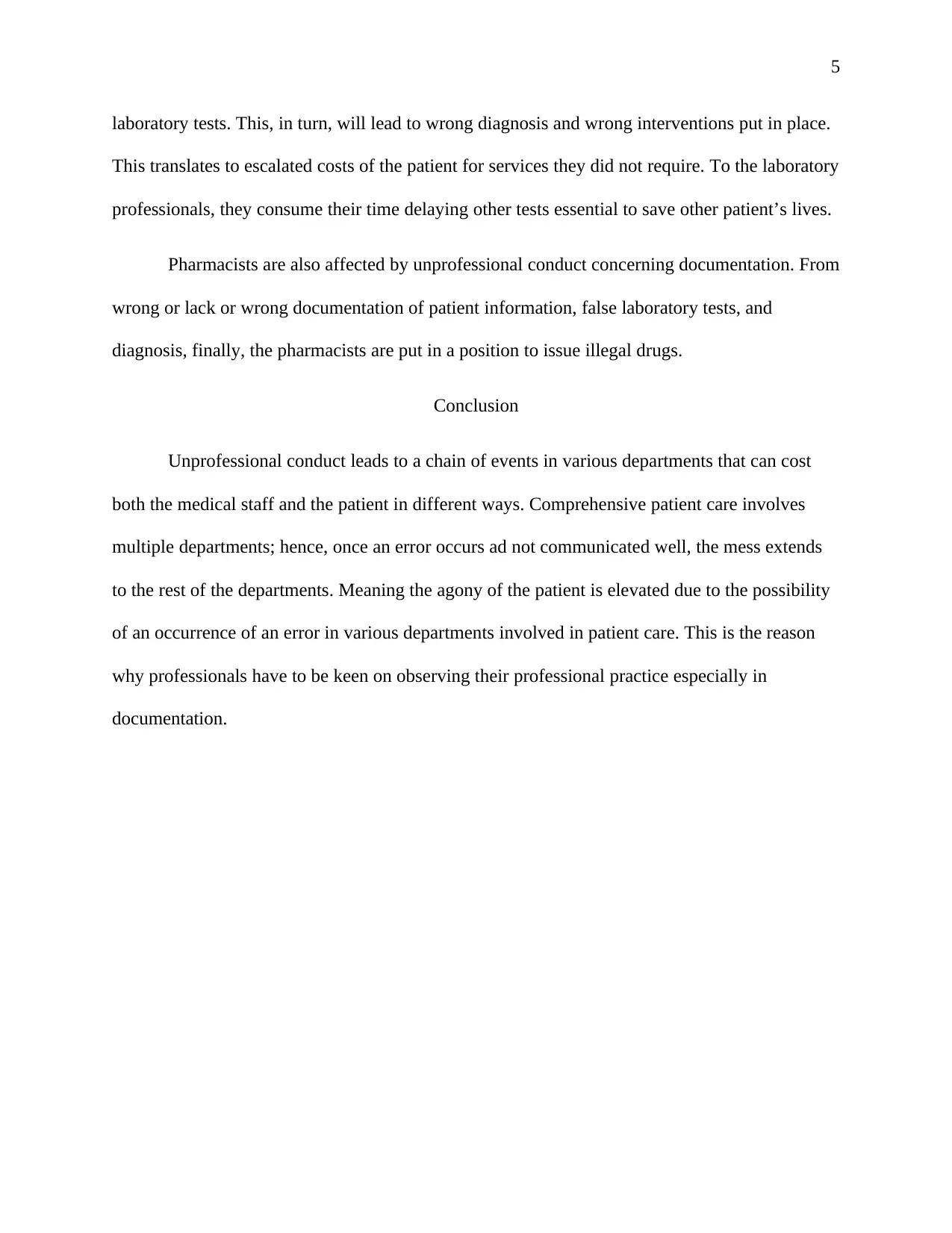
5
laboratory tests. This, in turn, will lead to wrong diagnosis and wrong interventions put in place.
This translates to escalated costs of the patient for services they did not require. To the laboratory
professionals, they consume their time delaying other tests essential to save other patient’s lives.
Pharmacists are also affected by unprofessional conduct concerning documentation. From
wrong or lack or wrong documentation of patient information, false laboratory tests, and
diagnosis, finally, the pharmacists are put in a position to issue illegal drugs.
Conclusion
Unprofessional conduct leads to a chain of events in various departments that can cost
both the medical staff and the patient in different ways. Comprehensive patient care involves
multiple departments; hence, once an error occurs ad not communicated well, the mess extends
to the rest of the departments. Meaning the agony of the patient is elevated due to the possibility
of an occurrence of an error in various departments involved in patient care. This is the reason
why professionals have to be keen on observing their professional practice especially in
documentation.
laboratory tests. This, in turn, will lead to wrong diagnosis and wrong interventions put in place.
This translates to escalated costs of the patient for services they did not require. To the laboratory
professionals, they consume their time delaying other tests essential to save other patient’s lives.
Pharmacists are also affected by unprofessional conduct concerning documentation. From
wrong or lack or wrong documentation of patient information, false laboratory tests, and
diagnosis, finally, the pharmacists are put in a position to issue illegal drugs.
Conclusion
Unprofessional conduct leads to a chain of events in various departments that can cost
both the medical staff and the patient in different ways. Comprehensive patient care involves
multiple departments; hence, once an error occurs ad not communicated well, the mess extends
to the rest of the departments. Meaning the agony of the patient is elevated due to the possibility
of an occurrence of an error in various departments involved in patient care. This is the reason
why professionals have to be keen on observing their professional practice especially in
documentation.
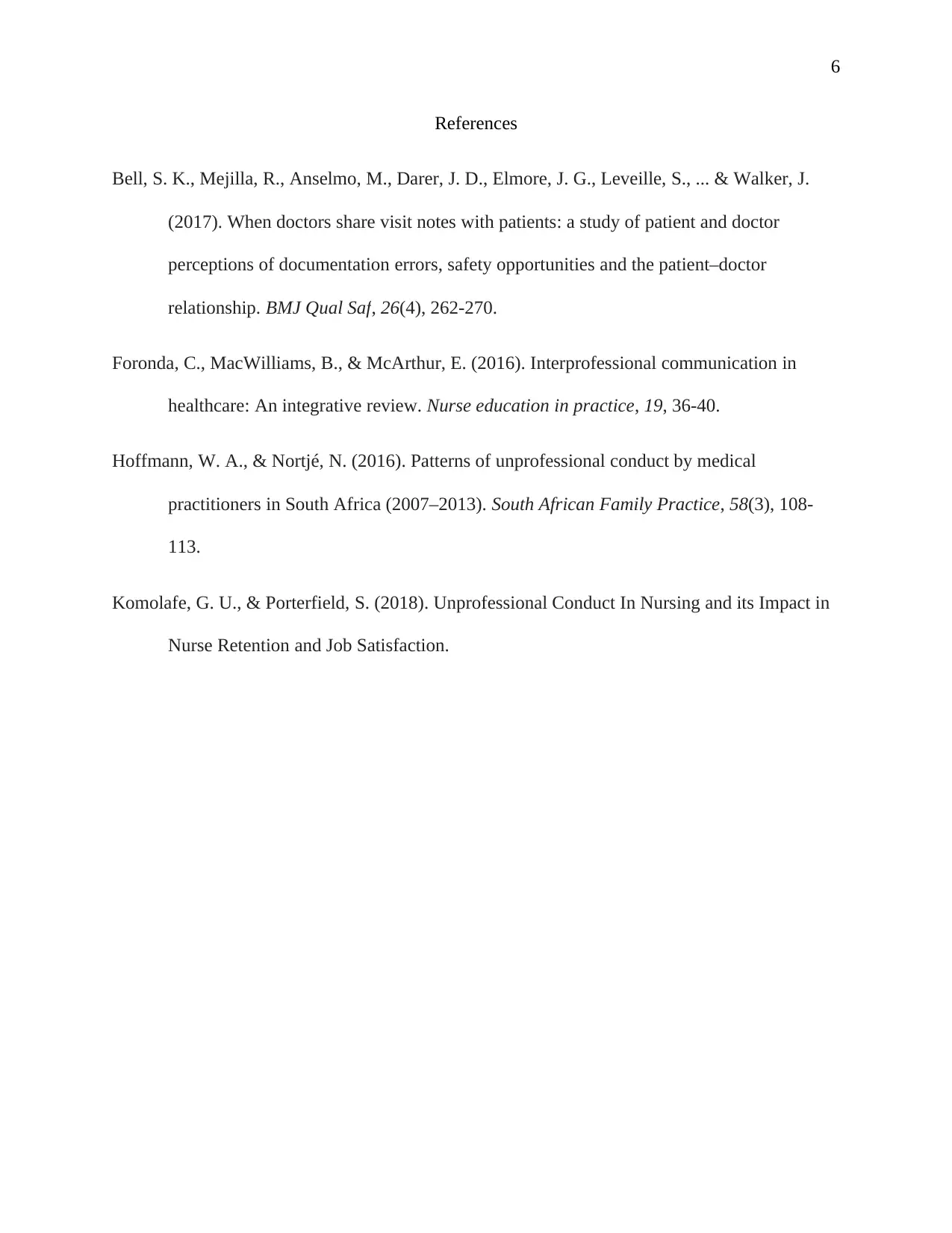
6
References
Bell, S. K., Mejilla, R., Anselmo, M., Darer, J. D., Elmore, J. G., Leveille, S., ... & Walker, J.
(2017). When doctors share visit notes with patients: a study of patient and doctor
perceptions of documentation errors, safety opportunities and the patient–doctor
relationship. BMJ Qual Saf, 26(4), 262-270.
Foronda, C., MacWilliams, B., & McArthur, E. (2016). Interprofessional communication in
healthcare: An integrative review. Nurse education in practice, 19, 36-40.
Hoffmann, W. A., & Nortjé, N. (2016). Patterns of unprofessional conduct by medical
practitioners in South Africa (2007–2013). South African Family Practice, 58(3), 108-
113.
Komolafe, G. U., & Porterfield, S. (2018). Unprofessional Conduct In Nursing and its Impact in
Nurse Retention and Job Satisfaction.
References
Bell, S. K., Mejilla, R., Anselmo, M., Darer, J. D., Elmore, J. G., Leveille, S., ... & Walker, J.
(2017). When doctors share visit notes with patients: a study of patient and doctor
perceptions of documentation errors, safety opportunities and the patient–doctor
relationship. BMJ Qual Saf, 26(4), 262-270.
Foronda, C., MacWilliams, B., & McArthur, E. (2016). Interprofessional communication in
healthcare: An integrative review. Nurse education in practice, 19, 36-40.
Hoffmann, W. A., & Nortjé, N. (2016). Patterns of unprofessional conduct by medical
practitioners in South Africa (2007–2013). South African Family Practice, 58(3), 108-
113.
Komolafe, G. U., & Porterfield, S. (2018). Unprofessional Conduct In Nursing and its Impact in
Nurse Retention and Job Satisfaction.
⊘ This is a preview!⊘
Do you want full access?
Subscribe today to unlock all pages.

Trusted by 1+ million students worldwide
1 out of 6
Related Documents
Your All-in-One AI-Powered Toolkit for Academic Success.
+13062052269
info@desklib.com
Available 24*7 on WhatsApp / Email
![[object Object]](/_next/static/media/star-bottom.7253800d.svg)
Unlock your academic potential
Copyright © 2020–2025 A2Z Services. All Rights Reserved. Developed and managed by ZUCOL.




